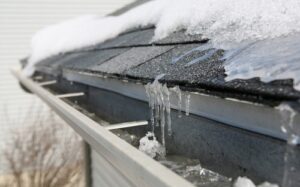
Did you know that the average winter temperature in Kentucky is around around 36°F? That’s definitely quite chilly but doesn’t match West Central Florida’s warm winters that average in the 60’s!
Kentucky often sees rain, snow, and ice, making for a winter of wild weather. Although strong and durable, every home’s roof can be damaged by bad weather if it’s not properly looked after. To help protect your home throughout the year, here are our top winter roof maintenance tips. Number 1 and 2 may not impact our Florida home owners, but the other tips do apply as things to look for and maintain in any climate.
- Remove Any Snow Fall
When it comes to winter roof maintenance tips, you can’t ignore the snow! While it can look gorgeous to have a home blanketed in white, if the cold stays around for long periods of time, letting it sit could start to play havoc on your roof. Snow, like ice, is heavy, and just a few inches will create a heavy load and excellerate issues your roof may have.
- Be Aware of Ice
When it’s not snowing, you need to be aware of ice. Ice can also be heavy, but more than that, it can lead to an ice dam which is dangerous on any roof. As water on your roof flows towards your gutters and temperatures drop overnight, it freezes in and around the guttering. This can lead to a backup of any other water which can also freeze, causing damage to your shingles and creating leaks.
Hire roof services to take care of ice for you. As it’s slippery, it’s best to call out a professional to deal with it for you to avoid any personal injuries.
- Fix Your Flashing
If you’re looking into roof care during the winter, don’t forget your flashing. Even if it was put in correctly just a few years ago, flashing could quickly become loose or warped, leading to many problems.
Broken flashing can allow snow and icy water to enter your roof, leading to potential leaks inside your home. Not ideal! Carry out a check on your flashing before the cold weather hits to reduce the chance of issues.
This also applies to your roof shingles. If any of yours look as though they’ve moved or chipped, call in roof repair services to inspect and fix it.
- Check Your Gutters Regularly
If you have a problem with ice and snow, your gutters are usually the first place that you’ll see problems. Check them regularly for build-up and ice dams. In general, if you see icicles hanging from your gutters, you likely have a problem, and the area needs clearing.
If you leave your gutters to fill with ice, they’re going to have much more weight than they can handle and become weak. In worst-case scenarios, they can come away from your home and cause a lot of structural damage, leading to a large repair bill.
- Don’t Underestimate Wind Damage
Snow and ice are the most pressing weather matters you need to be aware of but don’t underestimate the wind. Heavy winds and storms are common in the colder months, and they can cause just as many problems!
After heavy wind, inspect your roof for any signs of damage. Look for broken or missing shingles, check your gutters are still working, and do a general review of the area. If left unchecked, these can lead to vulnerable spots for leaks, so get them repaired quickly!
- Keep an Eye on Your Attic
The state of your attic is directly linked to the condition of your roof. If you don’t go up there often, you may miss signs of leaks and other issues until they’ve caused many problems, which you definitely don’t want!
You also need to ensure your attic has excellent ventilation and insulation. You may not realize it, but these two things can have a direct impact on your roof and leave them more exposed to the elements. When conducting roof maintenance, head into your attic to ensure there are clear routes for ventilation and your insulation is working as it should.
- Clear Any Debris
Debris can wreak havoc on your roof, especially in the winter! Before storms start to roll in and snow comes down, be sure to check your roof and surrounding areas (such as gutters and downspouts) for debris. You want them to be completely free of leaves, stones, pine needles, and any other loose items that can accumulate on the surface.
If you can clear all this debris before a storm hits, the moisture doesn’t have as much to grip onto and soak. If there is debris, the items will likely become sodden and rot, which can lead to roof damage.

